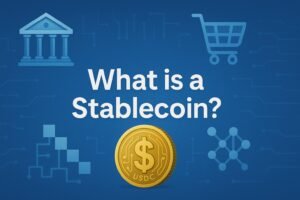A stablecoin is a cryptocurrency designed to maintain a stable value by being pegged to traditional assets like the U.S. dollar, euro, or gold. Unlike Bitcoin, which can fluctuate dramatically, stablecoins aim to combine the benefits of digital currency with price stability.
When people ask “what is a stablecoin,” the simplest answer is: it’s a digital version of traditional money that lives on the blockchain. Think of stablecoins as the bridge between volatile cryptocurrencies and stable fiat currencies. Need a refresher on what is decentralized finance? Check out our recent article here.
How Do Stablecoins Work?
Stablecoins maintain their stability through different backing mechanisms. Understanding what is a stablecoin means knowing these four main types:
Fiat-Backed Stablecoins
- What they are: Backed 1:1 by traditional currencies like USD
- Examples: USDC, USDT (Tether)
- How they work: For every stablecoin issued, one dollar is held in reserve
Crypto-Backed Stablecoins
- What they are: Backed by other cryptocurrencies (overcollateralized)
- Examples: DAI
- How they work: Use excess crypto collateral to maintain the peg
Algorithmic Stablecoins
- What they are: Use smart contracts and algorithms to control supply
- Examples: FRAX (note: Terra’s UST famously failed)
- How they work: Automatically mint or burn tokens to maintain price
Commodity-Backed Stablecoins
- What they are: Pegged to physical assets like gold
- Examples: PAXG
- How they work: Each token represents ownership of real-world commodities
Why Stablecoins Matter for Digital Payments
Stablecoins solve a critical problem in cryptocurrency: price volatility. Here’s why they’re becoming essential for digital commerce:
Key Benefits of Stablecoins
- Lower transaction fees compared to credit cards (typically 1-3% vs 3-5%)
- Faster settlement – often within minutes instead of days
- Global accessibility – no currency conversion needed
- 24/7 availability – unlike traditional banking systems
- Reduced chargeback risk for merchants
Real-World Stablecoin Use Cases
- E-commerce payments – Direct checkout with USDC or USDT
- International remittances – Send money globally without high fees
- DeFi lending – Earn yield on stable digital assets
- Business treasury management – Hold digital cash equivalents
Major Players in the Stablecoin Space
Traditional Payment Giants Adapting
PayPal’s Stablecoin Strategy
- Launched PYUSD (PayPal USD) stablecoin
- Integrated stablecoin trading into PayPal and Venmo
- Positioning as the mainstream gateway to digital currencies
Visa’s Blockchain Integration
- Enables USDC settlement on Ethereum and Solana networks
- Powers crypto debit cards through partnerships
- Focuses on being the infrastructure layer for crypto payments
Crypto-Native Payment Platforms
Coinbase Commerce
- Direct stablecoin checkout for e-commerce
- Integrates with Shopify, WooCommerce, and major platforms
- Offers both crypto and fiat settlement options
Solana Pay
- Ultra-fast, low-cost USDC transactions
- Point-of-sale and online payment solutions
- Targets merchants wanting instant settlement
Circle (USDC Issuer)
- Provides APIs for businesses to integrate stablecoins
- Offers programmable wallets and payment solutions
- Powers many stablecoin applications behind the scenes
The Future of Stablecoin Payments
The stablecoin landscape is rapidly evolving. When considering what is a stablecoin’s role in the future, several trends emerge:
Growing Adoption
- Major retailers beginning to accept stablecoin payments
- Integration with traditional e-commerce platforms increasing
- Central bank digital currencies (CBDCs) following similar models
Regulatory Clarity
- Governments developing frameworks for stablecoin regulation
- Focus on reserve requirements and transparency
- Potential for regulated stablecoins to gain wider acceptance
Technical Improvements
- Layer 2 solutions reducing transaction costs further
- Cross-chain interoperability improving
- Better user experience through wallet integrations
Risks and Considerations
While stablecoins offer significant advantages, they’re not without risks:
Potential Risks
- Regulatory uncertainty – Rules are still developing
- Counterparty risk – Dependence on reserve backing
- Technical risks – Smart contract vulnerabilities
- Liquidity concerns – During market stress periods
Due Diligence Tips
- Research the backing mechanism and reserve audits
- Understand the issuer’s regulatory compliance
- Consider the blockchain network’s security and reliability
- Evaluate integration options for your specific use case
Getting Started with Stablecoins
For businesses considering stablecoin integration:
- Choose the right stablecoin – USDC and USDT are most widely accepted
- Select a payment processor – Coinbase Commerce, BitPay, or direct integration
- Consider your customers – Ensure they understand and want crypto payment options
- Plan for accounting – Understand tax and reporting implications
- Start small – Test with a limited rollout before full implementation
Conclusion
What is a stablecoin? It’s a cryptocurrency that maintains stable value through various backing mechanisms, offering the benefits of digital currency without extreme price volatility. As adoption grows and technology improves, stablecoins are positioned to play an increasingly important role in digital commerce.
Whether you’re a business owner considering new payment methods or someone curious about cryptocurrency alternatives, stablecoins represent a practical bridge between traditional finance and the digital future. With major companies like PayPal and Visa investing heavily in this space, stablecoins are moving from experimental technology to mainstream payment infrastructure.
The next time you see “Pay with USDC” as a checkout option, you’ll understand exactly what that means and why it might be worth considering.





